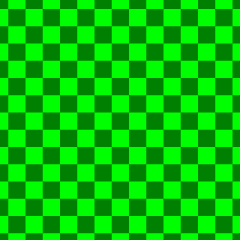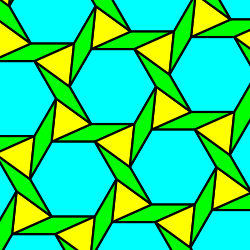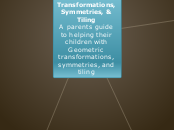Guide to Transformations, Symmetries, & Tiling
A parents guide to helping their children with Geometric transformations, symmetries, and tiling
Games!
Here I have put a couple of links to sites that have games about gemetric transformations, symmetries, and tiling. I am only allowed one hyperlink attachment, so the web address is in the notes section.
Symmetry
Definition: Any rigid motion of the plane that moves all the points of the figure back to points of the figure. There can be Horizontal, Vertical, and many more!
Reflection Symmetry (Also called Bilateral Symmetry or Line Symmetry:

Example of Reflection Symmetry
Rotational Symmetry (Also called Turn Symmetry):

Example of Rotational Symmetry
Point Symmetry:
The BLOCK letters H, I, N, O, S, X, & Z are examples of Point Symmetry.
Periodic Patterns:
Border Patterns:

Example of Border Pattern
Wallpaper Pattern:

Example of Wallpaper Pattern
Video about Symmetry
Resources
Transformational Geometry
Definition: Every point P is moved from a starting position to a final position P'.
Rigid Motion: Every pair of points P and Q moves to P' and Q' in a way that leaves the distance unchanged; that is, PQ = P'Q'. This does not allow for shrinking or stretching. There are 4 basic types.
Rigid Motion is also called isometry, meaning "same measure"
1. Translation or Slide:

Translation/Slide Example
2. Rotation or Turn:

Rotation/Turn Example
3. Reflection or Flip:

Reflection/Flip Example
4. Glide-reflection or Glide:

Glide-Reflection Example
Video explaining 4 types of Rigid Motion

Tiling (and Escher-like designs)
Tiles and Tiling Definition: Tiles are simple closed curves together with its interior. Tiling is the result of individual tiles covering a shape placed so their interior never overlaps. Tiling is also called Tesselations.
Regular Tiling:
There are only 3 shapes that allow regular tiling:
1. equilateral triangles
2. squares
3. regular hexagon

Equilateral triangle tiling

Square tiling

Regular hexogon tiling
Semiregular Tiling:

Example of semiregular tiling
Tiling with Congruent Polygonal Shapes:

Example of tiling with congruent polygons
Video about Escher designs
Maurits Cornelius Escher (1898-1972) was a Dutch artist. He was famous for his bird designs he created. He would first start with a parallelogram and replace an edge of the parallelogram with a curve and translate this curve to the opposite side of the parallelogram, and then on the opposite parallel sides, make a curve and translate it to the other side.
